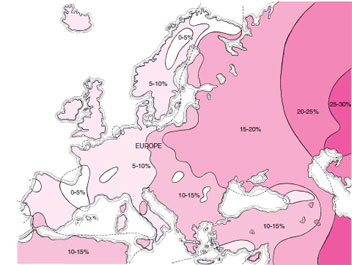Microevolution: Genetic Variation and Change within Species
Microevolution:
Genetic Variation
and Change within
Species
Microevolution is the study of genetic
change occurring within natural populations.
The observation of different
allelic forms of a gene in a population
is called polymorphism. All alleles of
all genes possessed by members of a
population collectively form the gene
pool of that population. The amount
of polymorphism present in large populations
is potentially enormous,
because at observed mutation rates,
many different alleles are expected for
all genes.
Population geneticists study polymorphism by identifying the different allelic forms of a gene that are present in a population and then measuring the relative frequencies of the different alleles in the population. The relative frequency of a particular allelic form of a gene in a population is known as its allelic frequency. For example, in the human population, there are three different allelic forms of the gene encoding the ABO blood types. Using the symbol I to denote the gene encoding the ABO blood types, IA and IB denote genetically codominant alleles encoding blood types A and B, respectively. Allele i is a recessive allele encoding blood group O. Therefore genotypes IAIA and IAi produce type A blood, genotypes IBIB and IBi produce type B blood, genotype IAIB produces type AB blood, and genotype ii produces type O blood. Because each individual contains two copies of this gene, the total number of copies present in the population is twice the number of individuals. What fraction of this total is represented by each of the three different allelic forms? In the French population, we find the following allelic frequencies: IA = .46, IB = .14, and i = .40. In the RussIAn population, the corresponding allelic frequencies differ (IA = .38, IB = .28, and i = .34), demonstrating microevolutionary divergence between these populations (see Figure 6-27). Although alleles IA and ib are dominant to i, i is nearly as frequent as IA and exceeds the frequency of ib in both populations. Dominance describes the phenotypic effect of an allele in heterozygous individuals, not its relative abundance in a population of individuals. We will demonstrate that Mendelian inheritance and dominance do not alter allelic frequencies directly or produce evolutionary change in a population.
 |
| Figure 6-27 Frequencies of the blood-type B allele among humans in Europe. The allele is more common in the east and rarer in the west. The allele may have arisen in the east and gradually diffused westward through the genetic continuity of human populations. This allele has no known selective advantage; its changing frequency probably represents the effects of random genetic drift. |
Population geneticists study polymorphism by identifying the different allelic forms of a gene that are present in a population and then measuring the relative frequencies of the different alleles in the population. The relative frequency of a particular allelic form of a gene in a population is known as its allelic frequency. For example, in the human population, there are three different allelic forms of the gene encoding the ABO blood types. Using the symbol I to denote the gene encoding the ABO blood types, IA and IB denote genetically codominant alleles encoding blood types A and B, respectively. Allele i is a recessive allele encoding blood group O. Therefore genotypes IAIA and IAi produce type A blood, genotypes IBIB and IBi produce type B blood, genotype IAIB produces type AB blood, and genotype ii produces type O blood. Because each individual contains two copies of this gene, the total number of copies present in the population is twice the number of individuals. What fraction of this total is represented by each of the three different allelic forms? In the French population, we find the following allelic frequencies: IA = .46, IB = .14, and i = .40. In the RussIAn population, the corresponding allelic frequencies differ (IA = .38, IB = .28, and i = .34), demonstrating microevolutionary divergence between these populations (see Figure 6-27). Although alleles IA and ib are dominant to i, i is nearly as frequent as IA and exceeds the frequency of ib in both populations. Dominance describes the phenotypic effect of an allele in heterozygous individuals, not its relative abundance in a population of individuals. We will demonstrate that Mendelian inheritance and dominance do not alter allelic frequencies directly or produce evolutionary change in a population.




